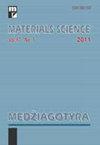The Photocatalytic Activity of the Bi2O3-B2O3-ZnO-TiO2 Glass Coating
IF 0.6
4区 材料科学
Q4 MATERIALS SCIENCE, MULTIDISCIPLINARY
引用次数: 0
Abstract
Due to the low melting temperature, the glazes based on the Bi2O3-B2O3-ZnO system are used as coatings on the surface of industrial glass substrates. Moreover, the composition of these coatings does not contain PbO, meeting the optical and environmental properties requirements. In this study, TiO2 was used in the Bi2O3-B2O3-ZnO glaze system to improve its photocatalytic ability. This can be considered a four – component glass system Bi2O3-B2O3-ZnO-TiO2. The heating microscopy results show that the melting temperature of the glaze system is 606 °C. The Fourier transform infrared spectroscopy results show that the TiO2 polyhedra are located independently in the structure without participating in forming a glass network. Thanks to that, the photocatalytic properties of TiO2 are maintained. The X-ray diffraction patterns results show that the formed TiO2 nanocrystals are rutile and anatase crystals. The results of determining the band gap energy using UV-Vis show that the band gap energy of the base glaze system increases with the addition of TiO2. The methylene blue decomposition results also showed that the ability to decompose organic increased when TiO2 was added to the glaze coating. The characteristics such as melting temperature, microstructure, and photocatalytic capacity of Bi2O3-B2O3-ZnO-TiO2 white glazes (5 and 10 % weight of TiO2) also were indicated in this paper.Bi2O3-B2O3-ZnO-TiO2玻璃涂层的光催化活性研究
由于熔融温度低,基于Bi2O3-B2O3-ZnO体系的釉料被用作工业玻璃基板表面的涂层。此外,这些涂层的组成不含PbO,满足光学和环境性能要求。本研究将TiO2加入到Bi2O3-B2O3-ZnO釉料体系中,以提高其光催化能力。这可以被认为是一个四组分的玻璃系统Bi2O3-B2O3-ZnO-TiO2。加热显微分析结果表明,釉料体系的熔化温度为606℃。傅里叶变换红外光谱结果表明,TiO2多面体在结构中独立分布,不参与形成玻璃网络。因此,TiO2的光催化性能得以保持。x射线衍射结果表明,制备的TiO2纳米晶为金红石型和锐钛矿型。紫外可见光谱法测定带隙能的结果表明,随着TiO2的加入,基釉体系的带隙能增大。亚甲基蓝分解结果也表明,在釉料涂层中加入TiO2后,其对有机物的分解能力有所提高。研究了Bi2O3-B2O3-ZnO-TiO2白釉(TiO2质量分数为5%和10%)的熔融温度、微观结构和光催化性能。
本文章由计算机程序翻译,如有差异,请以英文原文为准。
求助全文
约1分钟内获得全文
求助全文
来源期刊

Materials Science-medziagotyra
工程技术-材料科学:综合
CiteScore
1.70
自引率
10.00%
发文量
92
审稿时长
6-12 weeks
期刊介绍:
It covers the fields of materials science concerning with the traditional engineering materials as well as advanced materials and technologies aiming at the implementation and industry applications. The variety of materials under consideration, contributes to the cooperation of scientists working in applied physics, chemistry, materials science and different fields of engineering.
 求助内容:
求助内容: 应助结果提醒方式:
应助结果提醒方式:


